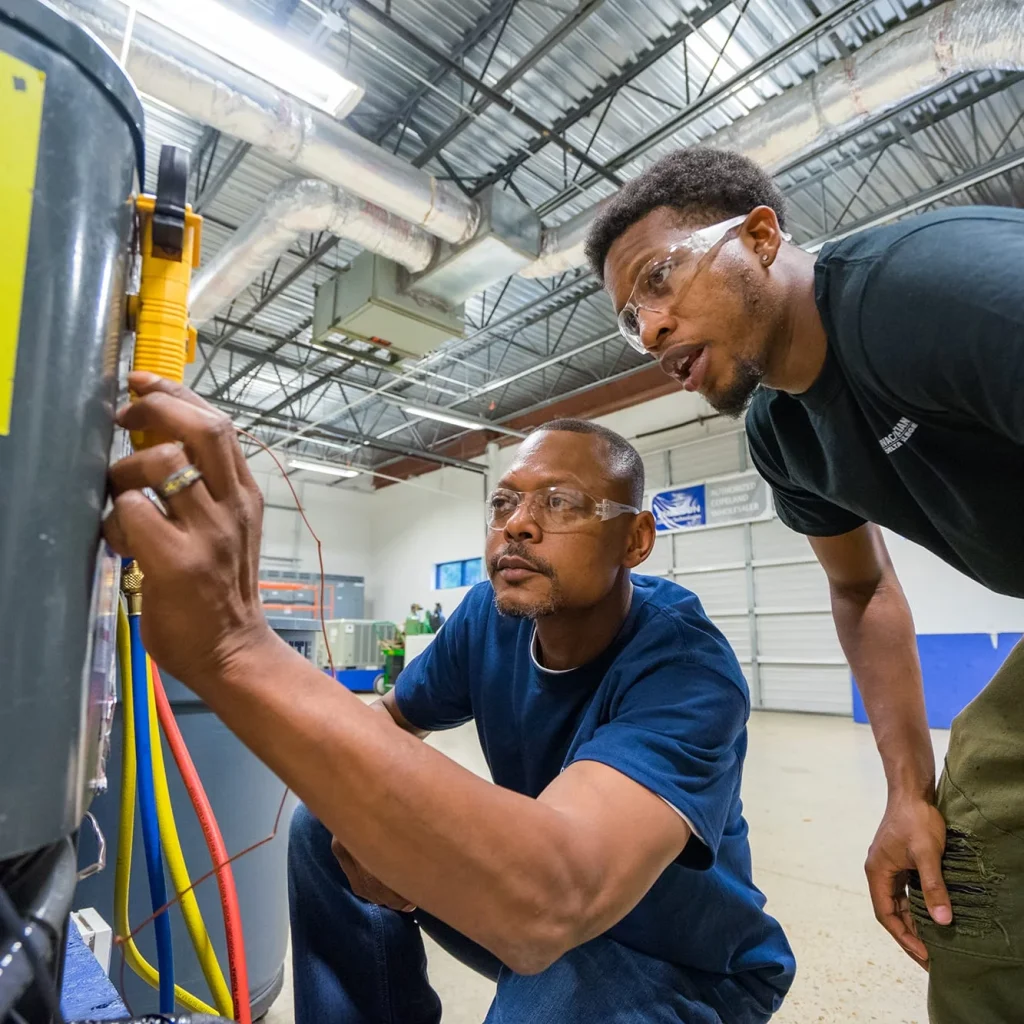HVAC Technician
Prepare for a stable and rewarding career in the heating, ventilation and air conditioning industry. This comprehensive program provides hands on training, safety knowledge and industry recognized certifications including OSHA 10, EPA Section 608 and NATE Ready to Work.

9 weeks
Program length
10–20 hours
Estimated weekly effort
$35,000
Average starting salary (estimated)
5%
Projected job growth (10 years, estimated)
5,000
Entry-level job openings (US, estimated)
Why Choose an HVAC Career?
Discover if you’ve got the right mindset — and why this trade offers one of the most stable, in-demand, and rewarding careers in the skilled trades.
Ideal Personality
You are a Problem Solver:
You enjoy fixing things, working with your hands, and seeing real-world results. You’re detail-oriented, patient under pressure, and not afraid of a little dirt or hard work.
What the Work Is Like
You’ll diagnose, install, and repair heating, ventilation, and air-conditioning systems for homes, businesses, and industrial facilities. Expect hands-on work with tools, electrical systems, refrigerants, and tech controls. It’s physical, technical, and results-driven.
Job Security
Extremely High. Every building needs climate control — in every season and economy. HVAC techs stay in demand year-round across residential, commercial, and industrial sectors.
Bonus Benefits
Many employers offer paid apprenticeships, certifications, and overtime pay. You can also grow into specialties like refrigeration, energy efficiency, or system design — increasing both your value and income potential.
Program overview
What does an Entry Level HVAC Technician do?
Entry level HVAC Technicians assist with installation, maintenance and repair of heating, ventilation and air conditioning systems. They perform routine inspections, clean and replace filters, troubleshoot electrical and mechanical components, handle refrigerants, test systems for efficiency and safety and ensure compliance with environmental and safety regulations.
- Understand the basics of HVAC systems and core functions.
- Identify key components and perform routine maintenance.
- Diagnose and repair electrical circuits, motors, residential air conditioning systems and heat pumps.
- Explain refrigeration principles, including relationships between temperature, pressure and heat transfer.
- Handle refrigerants safely in accordance with EPA guidelines.
- Recognize worker rights and employer responsibilities for jobsite safety.
- Develop a safety first mindset and foundational jobsite skills.

Certifications earned / eligible for
- OSHA 10 Hour Construction Industry Certificate – covers workplace safety and hazard prevention.
- EPA Section 608 Certification – required for handling refrigerants.
- NATE Ready to Work Certificate – industry recognized proof of entry level HVAC competency.
Career opportunities summary
Graduates are prepared for entry level positions such as HVAC Apprentice, HVAC Installer, HVAC Service Technician, Refrigeration Technician and Maintenance Technician. With experience, technicians may advance to journeyman, supervisor or estimator roles.
Program details
Program structure overview: The curriculum consists of multiple modules with online lectures and in‑person skill labs. Students have access to materials for up to 12 months but can complete the course in 5–9 weeks depending on study commitment.

Structure & Curriculum
Module 1 - What is HVAC? (3–4 hours)
Defines HVAC systems, their functions and safety practices.
Module 2 - HVAC Components (3–4 hours)
Identifies components and explains how they work together.
Module 3 - Tool Identification and Selection (2–3 hours)
Introduces tools used in HVAC work and proper selection.
Module 4 - Measurements and Units (2 hours)
Covers measurements, units and basic calculations.
Module 5 - Basic Heat Transfer (2 hours)
Explains principles of heat transfer and thermodynamics.
Module 6 - General Safety (4 hours)
Introduces OSHA requirements, workplace hazards and safe practices.
Module 7 - Electrical Safety (2 hours)
Covers safety practices when working with electrical components.
Module 8 - Compressed Gas Safety (2 hours)
Teaches safe handling of compressed gases.
Module 9 - Electrical for HVAC/R (8–12 hours)
Introduces electrical parts, circuits and tools used in HVAC systems; includes troubleshooting.
Module 11 - HVAC Refrigeration Principles (8–12 hours)
Explains refrigeration cycles, relationships between temperature, pressure and heat transfer.
Module 12 - HVAC Evacuation & Charging (4–8 hours)
Covers evacuation procedures, system charging and use of gauges.
Module 13 - HVAC Troubleshooting (12 hours)
Develops skills to diagnose and repair basic circuits, motors, residential A/C systems and heat pumps.
Module 14 - OSHA 10 Curriculum (10–14 hours)
Includes topics such as introduction to OSHA, walking working surfaces, emergency action plans, fire protection, electrical hazards, personal protective equipment, hazard communication, materials handling, machine guarding, industrial hygiene, bloodborne pathogens, ergonomics, safe driving, workplace violence prevention and safety and health programs.
Total program duration: 90 clock hours (~9 weeks)

Exam eligibility note
Upon completion and achieving a minimum 70% score, students are eligible to sit for the NATE Ready to Work, OSHA 10 Hour Construction Industry and EPA Section 608 certification exams; exam fees included.
AMA collaboration
Not applicable.
Enrollment requirements
- At least 18 years of age.
- High school diploma or GED.
- Proof of U.S. residency.
- English proficiency.
- No prerequisites.
- Access to a computer meeting minimum hardware requirements (1 GHz CPU, 2 GB RAM, 1280×720 resolution, speakers/headphones).
- Operating system: Windows 7/10 or Mac OS X 10+; Google Chrome browser and Adobe Reader.
- High speed internet connection.
Covered materials included with training
- Access to Learning Management System (LMS) and online lectures.
- All required program materials and eBooks.
- Certification exams for OSHA 10, NATE Ready to Work and EPA Section 608.
- Virtual reality simulation activities (if provided).
Student services / supports
- Student advisors available to answer questions via email or phone.
- Access to instructors for skills demonstrations and simulation support.
- Career services including resume help and job placement guidance.
- Access to program materials for 12 months from enrollment.
Career Outlook
The HVAC industry is expected to grow as buildings require maintenance and energy efficient systems. Entry level technicians are in demand and can advance quickly with additional certifications and experience.
Job roles & salary ranges
HVAC Apprentice
$28,000–$40,000
HVAC Installer
$35,000–$50,000
HVAC Service Technician
$30,000–$55,000
Data sources note: Salary estimates based on national averages; Alabama wages may be lower than national rates.
5,000
Entry-level job openings (US, estimated)
5%
Projected 10-year growth (estimated)
$35,000
Average starting salary (estimated)
Funding & grants
Financial aid may be available through workforce programs, military spouse grants and employer reimbursement.
Funding options listed
- WIOA grants via local American Job Centers.
- MyCAA funding for eligible military spouses.
- Employer tuition assistance for individuals already employed in HVAC or maintenance roles.
Military spouse grants note
MyCAA may provide up to $4,000 toward tuition for qualifying spouses.
Military spouse grants note:
Partnerships with local employers may provide internships or apprenticeships leading to employment.
Call to action for funding
Contact program advisers to explore funding options and eligibility.
Frequently Asked Questions
Students are prepared to earn OSHA 10, EPA Section 608 and NATE Ready to Work certifications upon successful completion.
The program comprises 90 clock hours and can be completed in as little as 5 weeks if committing 20 hours per week or 9 weeks at 10 hours per week.
You must be at least 18 years old, have a high school diploma or GED, proof of U.S. residency and English proficiency; there are no prerequisites.
A computer with at least a 1 GHz CPU, 2 GB RAM, 1280×720 resolution, speakers or headphones, Windows 7/10 or Mac OS X 10+, a high‑speed internet connection and Google Chrome browser.
Yes. While lectures are available online 24/7, the program includes in‑person skill labs for hands‑on practice.
Disclaimers & legal notes
Program hours, costs and curriculum are subject to change. Completion of the program does not guarantee employment; licensing requirements vary by state. Students are responsible for verifying state requirements and ensuring certifications meet local regulations.
